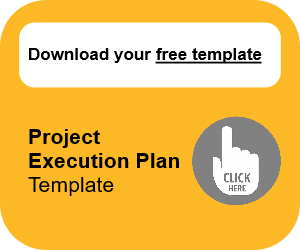Project execution plan PEP
A project execution plan (PEP, sometimes referred to as a 'project management plan or PMP' - see below) sets out the strategy for managing a project.
It describes who does what and how, defining the policies, procedures and priorities that will be adopted. It may include strategies in relation to items outside of the scope of the main contract, as the client's overall project might include multiple contracts for the supply of goods and services, both from external organisations and from within the client organisation itself, such as operation and maintenance contracts, the supply of equipment, relocation, and so on.
Project execution plans are generally prepared by the client's project director if they have sufficient experience, or on their behalf by a project manager. On a construction management contract or a management contract they may then be taken on and developed by the construction manager or management contractor.
They may, in the first instance, be based on information contained in the project business case and the strategic brief, but might then be developed to include:
- Project definition and a summary of the strategic brief or later the project brief.
- Drawings insofar as they are developed at this stage.
- Project programme.
- Cost plan, cost management and accounting procedures.
- Contracting and procurement strategy.
- Roles, responsibilities and authorities. This might be set out in a responsibility matrix (or project roles table), supplemented by a contractual tree and then used to develop a schedule of services for each appointment.
- Monitoring and reporting strategies.
- Potential consultations / stakeholder management.
- Communications strategy and standards.
- Technology strategy.
- Risk assessment and risk allocation.
- Strategy for obtaining planning permission and other permissions.
- Health and safety strategy.
- Sustainability strategy
- Quality assurance strategy.
- Soft landings strategy, including business change and staff training requirements, commissioning, handover, migration, aftercare and post occupation evaluation strategy.
- Operational strategy.
- Equipment requirements (inside or outside of the building contract).
- Unusual or long-lead items.
They are likely to be presented as a report, however, where possible, information and requirements should be scheduled in a database or spreadsheet format that will be easy to expand and will be easy to use to test whether proposals satisfy requirements later in the project
The progress of the project should be assessed against the project execution plan throughout the project and the project execution plan should be amended and developed as necessary.
Notes:
- There is some disagreement about whether this document should be described as a 'project execution plan'. It has been argued that the term 'execution plan' is more correctly applied to plans prepared by suppliers and that the client and their team actually prepare management plans. In this case, the client plan might better be described as a 'project management plan' (PMP). Other terms that might be used, include project implementation plan (PIP - although again some argue that this is a supplier document and it has recently been appropriated to have a specific meaning for BIM by PAS 1192-2 (now replaced by BS EN ISO 19650)), or simply 'project plan'.
- The RIBA Plan of Work 2013 suggests that the project execution plan; '...is produced in collaboration between the project lead and lead designer, with contributions from other designers and members of the project team. The Project Execution Plan sets out the processes and protocols to be used to develop the design. It is sometimes referred to as a 'project quality plan'.
- The Concept and Developed Design Quality Best Practice Self-Assessment Tool, published by the Chartered Quality Institute (CQI) Construction Special Interest Group (ConSIG) in 2021 and updated in 2022, defines a Project Management Plan as: ‘A plan provided by the Client/Owner including a description of the project, execution details project cost, schedule, risks, assumptions, resources, organization structure with roles and responsibilities, key deliverables etc. Note: Contractors may also have their own PMPs to control their part of the overall project.’
[edit] Related articles on Designing Buildings
- Appointing consultants.
- BIM Execution Plan.
- Briefing documents.
- Business case.
- Client.
- Collaborative practices.
- Conceiving construction plans.
- Document control.
- How to write a method statement.
- Method of procedure.
- Preliminary business case.
- Procurement route.
- Project brief.
- Project directory.
- Project implementation plan (for BIM).
- Projectisation.
- Project programme.
- Project quality plan.
- RACI matrix.
- Schedule of services.
- Strategic brief.
- Whole life costs.
[edit] External references
Featured articles and news
Moisture, fire safety and emerging trends in living walls
How wet is your wall?
Current policy explained and newly published consultation by the UK and Welsh Governments.
British architecture 1919–39. Book review.
Conservation of listed prefabs in Moseley.
Energy industry calls for urgent reform.
Heritage staff wellbeing at work survey.
A five minute introduction.
50th Golden anniversary ECA Edmundson apprentice award
Showcasing the very best electrotechnical and engineering services for half a century.
Welsh government consults on HRBs and reg changes
Seeking feedback on a new regulatory regime and a broad range of issues.
CIOB Client Guide (2nd edition) March 2025
Free download covering statutory dutyholder roles under the Building Safety Act and much more.
AI and automation in 3D modelling and spatial design
Can almost half of design development tasks be automated?
Minister quizzed, as responsibility transfers to MHCLG and BSR publishes new building control guidance.
UK environmental regulations reform 2025
Amid wider new approaches to ensure regulators and regulation support growth.
The maintenance challenge of tenements.
BSRIA Statutory Compliance Inspection Checklist
BG80/2025 now significantly updated to include requirements related to important changes in legislation.
Shortlist for the 2025 Roofscape Design Awards
Talent and innovation showcase announcement from the trussed rafter industry.























